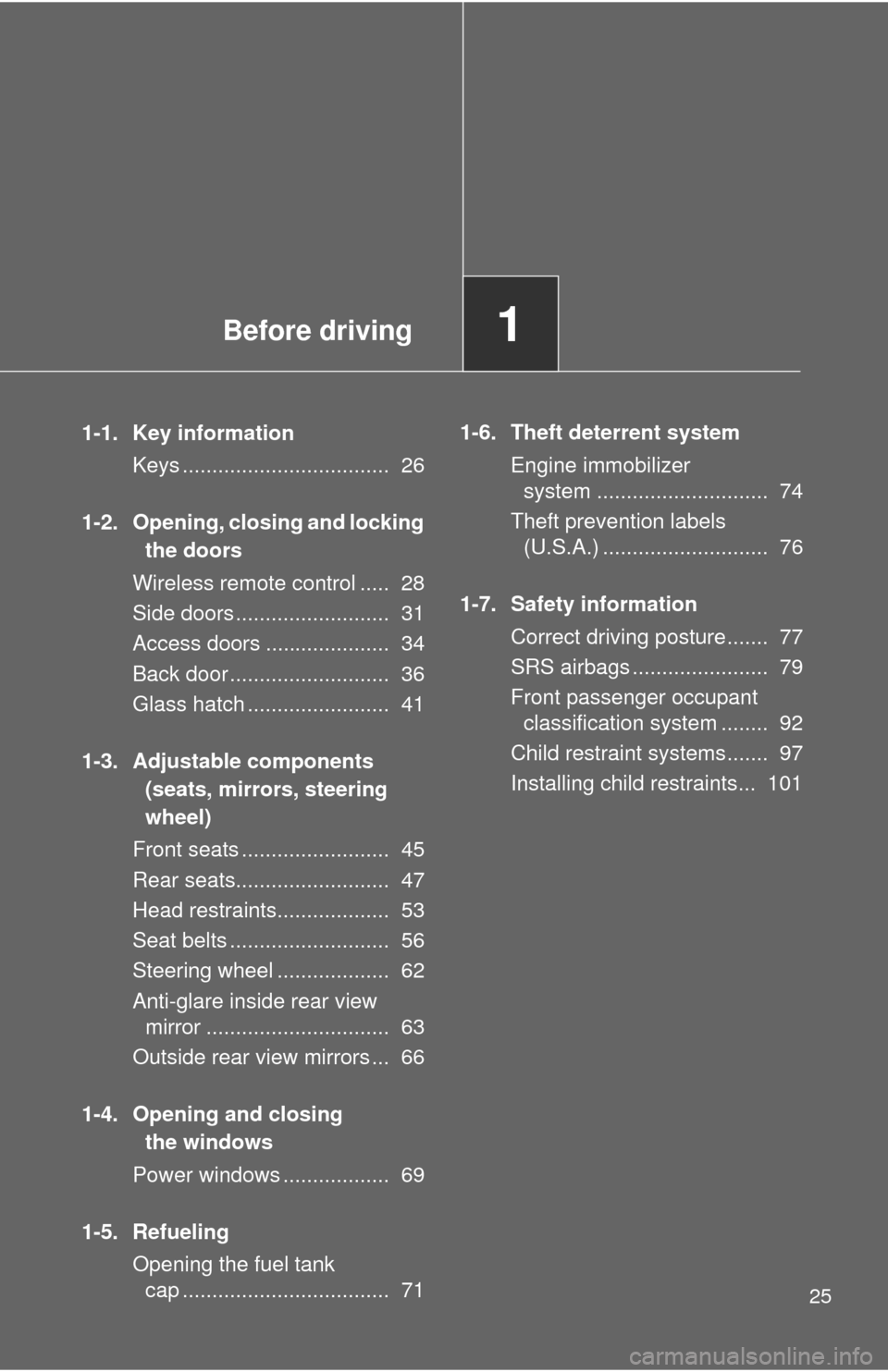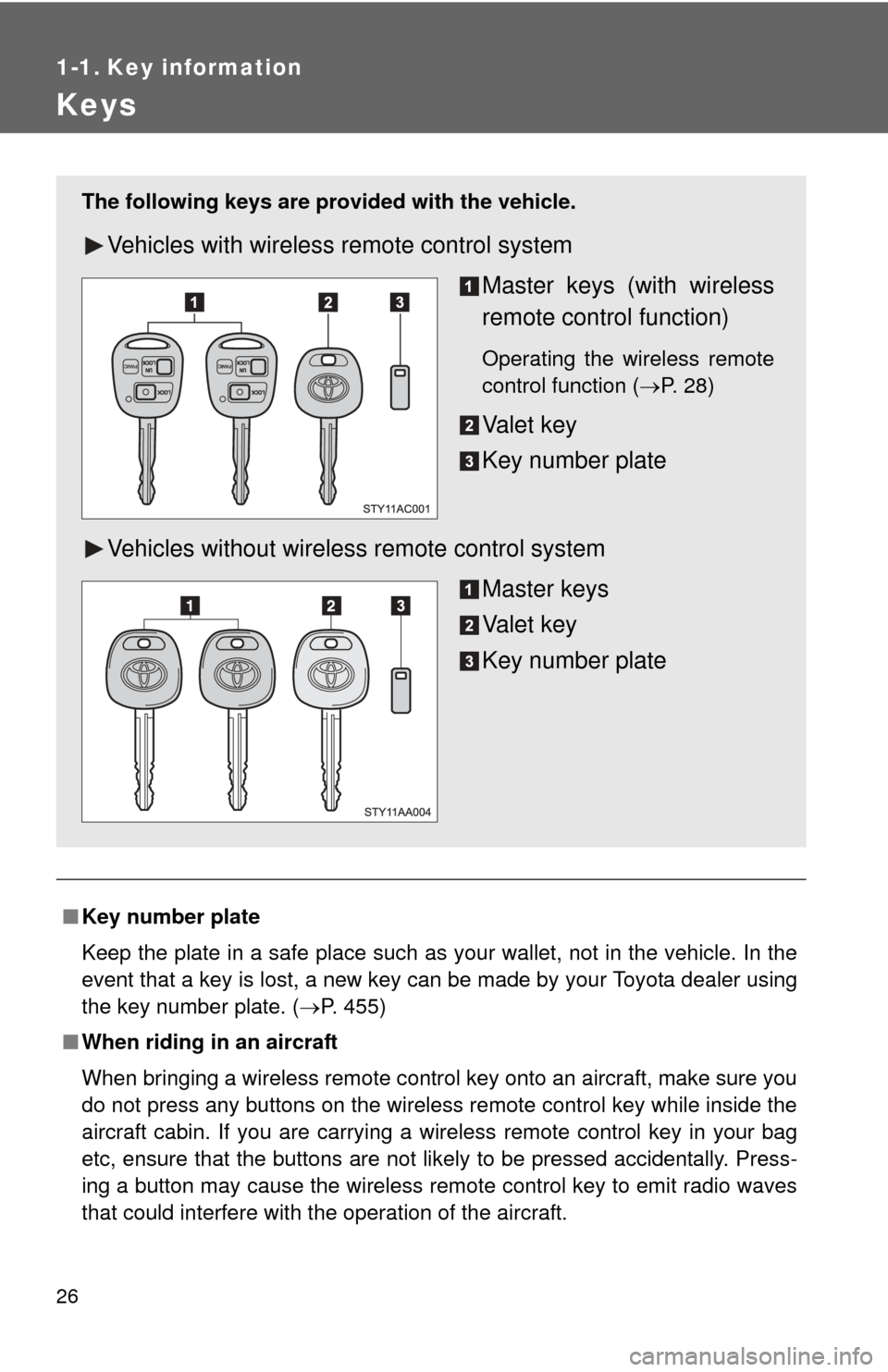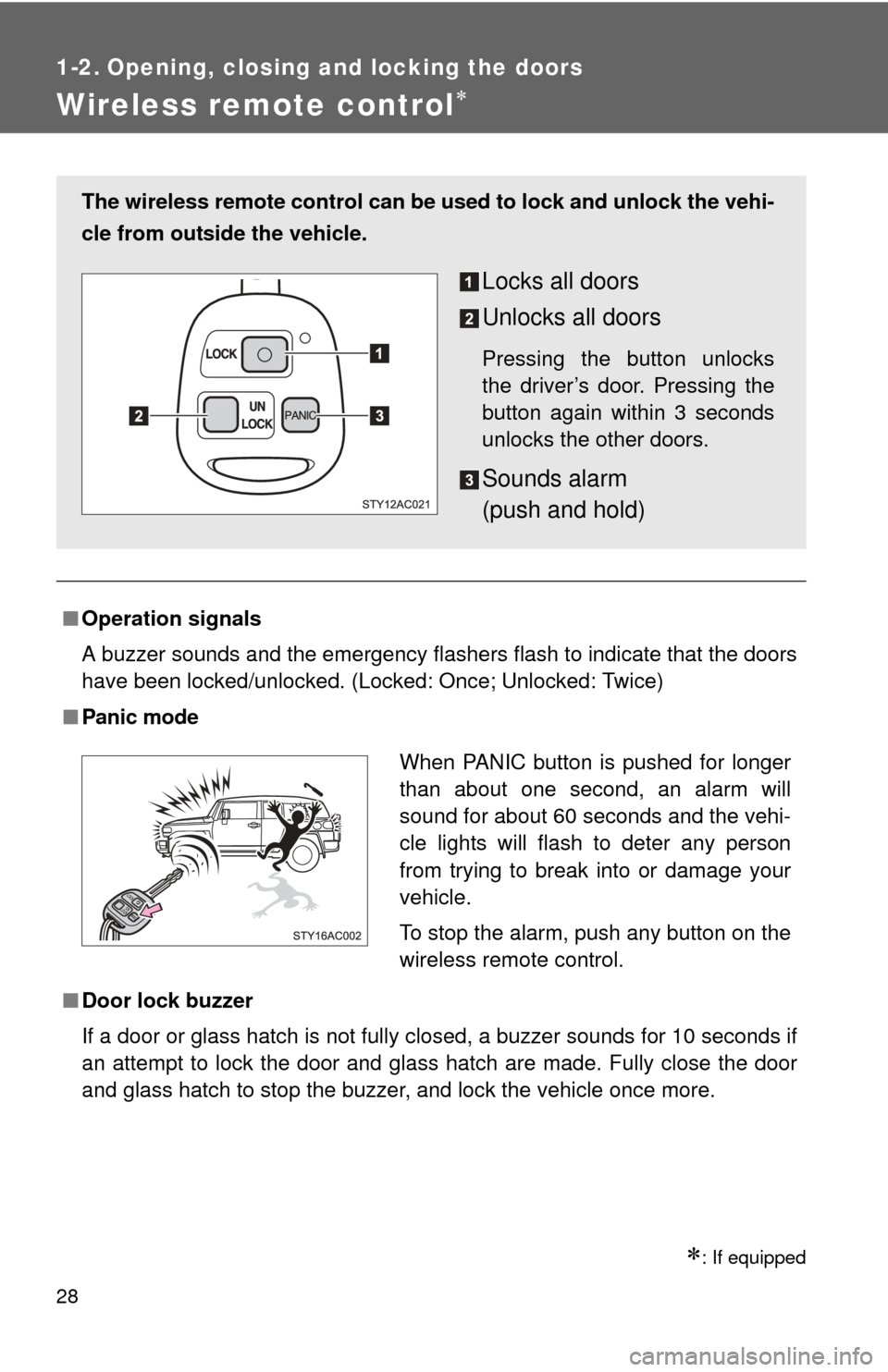Page 2 of 528

TABLE OF CONTENTSIndex
2
1-1. Key informationKeys ..................................... 26
1-2. Opening, closing and locking
the doors
Wireless remote control ....... 28
Side doors ............................ 31
Access doors........................ 34
Back door ............................. 36
Glass hatch .......................... 41
1-3. Adjustable components
(seats, mirrors, steering
wheel)
Front seats ........................... 45
Rear seats ............................ 47
Head restraints ..................... 53
Seat belts ............................. 56
Steering wheel ..................... 62
Anti-glare inside rear view mirror .................................. 63
Outside rear view mirrors ..... 66
1-4. Opening and clos ing
the windows
Pow er windows .................... 69
1-5. Refueling Opening the fuel tank cap .... 71 1-6. Theft deterrent system
Engine immobilizer system ................................ 74
Theft prevention labels (U.S.A.)............................... 76
1-7. Safety information Correct driving posture ......... 77
SRS airbags ......................... 79
Front passenger occupant classification system ........... 92
Child restraint systems ......... 97
Installing child restraints ..... 101
2-1. Driving procedures Driving the vehicle .............. 114
Engine (ignition) switch....... 124
Automatic Transmission ..... 127
Manual Transmission ......... 129
Turn signal lever ................. 131
Parking brake ..................... 132
Horn .................................... 134
2-2. Instrument cluster Gauges and meters ............ 135
Indicators and warning lights ................................. 138
Accessory meter ................. 141
1Before driving
2When driving
Page 17 of 528
17
Audio remote control switches P. 259
Telephone switch P. 283
Talk switch P. 283
Cruise control switch P. 148
: If equipped
Page 22 of 528

22
Installation of a mobile two-way radio system
As the installation of a mobile two-way radio system in your vehicle could
affect electronic systems such as the multiport fuel injection system/sequen-
tial multiport fuel injection system, cruise control system, anti-lock brake sys-
tem, SRS airbag system and seat belt pretensioner system, be sure to check
with your Toyota dealer for precautionary measures or special instructions
regarding installation.
Scrapping your Toyota
The SRS airbag and seat belt pretensioner devices in your Toyota contain
explosive chemicals. If the vehicle is scrapped with the airbags and seat belt
pretensioners left as they are, this may cause an accident such as fire. Be
sure to have the systems of the SRS airbag and seat belt pretensioner
removed and disposed of by a qualified service shop or by your Toyota
dealer before you scrap your vehicle.
Perchlorate Material
Special handling may apply,
See www.dtsc.ca.gov/hazardouswaste/perchlorate.
Your vehicle has components that may contain perchlorate. These compo-
nents may include airbag, seat belt pretensioners, and wireless remote con-
trol batteries.
Page 25 of 528

Before driving1
25
1-1. Key informationKeys ................................... 26
1-2. Opening, closing and locking the doors
Wireless remote control ..... 28
Side doors .......................... 31
Access doors ..................... 34
Back door ........................... 36
Glass hatch ........................ 41
1-3. Adjustable components (seats, mirrors, steering
wheel)
Front seats ......................... 45
Rear seats.......................... 47
Head restraints................... 53
Seat belts ........................... 56
Steering wheel ................... 62
Anti-glare inside rear view mirror ............................... 63
Outside rear view mirrors ... 66
1-4. Opening and closing the windows
Power windows .................. 69
1-5. Refueling Opening the fuel tank cap ................................... 71 1-6. Theft deterrent system
Engine immobilizer system ............................. 74
Theft prevention labels (U.S.A.) ............................ 76
1-7. Safety information Correct driving posture....... 77
SRS airbags ....................... 79
Front passenger occupant classification system ........ 92
Child restraint systems....... 97
Installing child restraints... 101
Page 26 of 528

26
1-1. Key information
Keys
■Key number plate
Keep the plate in a safe place such as your wallet, not in the vehicle. In the
event that a key is lost, a new key can be made by your Toyota dealer using
the key number plate. ( P. 455)
■ When riding in an aircraft
When bringing a wireless remote control key onto an aircraft, make sure you
do not press any buttons on the wireless remote control key while inside the
aircraft cabin. If you are carrying a wireless remote control key in your bag
etc, ensure that the buttons are not likely to be pressed accidentally. Press-
ing a button may cause the wireless remote control key to emit radio waves
that could interfere with the operation of the aircraft.
The following keys are provid ed with the vehicle.
Vehicles with wireless remote control system
Master keys (with wireless
remote control function)
Operating the wireless remote
control function (P. 28)
Va l e t k e y
Key number plate
Vehicles without wireless remote control system Master keys
Va l e t k e y
Key number plate
Page 28 of 528

28
1-2. Opening, closing and locking the doors
Wireless remote control
: If equipped
■Operation signals
A buzzer sounds and the emergency flashers flash to indicate that the doors
have been locked/unlocked. (Locked: Once; Unlocked: Twice)
■Panic mode
■Door lock buzzer
If a door or glass hatch is not fully closed, a buzzer sounds for 10 seconds if
an attempt to lock the door and glass hatch are made. Fully close the door
and glass hatch to stop the buzzer, and lock the vehicle once more.
The wireless remote control can be used to lock and unlock the vehi-
cle from outside the vehicle.
Locks all doors
Unlocks all doors
Pressing the button unlocks
the driver’s door. Pressing the
button again within 3 seconds
unlocks the other doors.
Sounds alarm
(push and hold)
When PANIC button is pushed for longer
than about one second, an alarm will
sound for about 60 seconds and the vehi-
cle lights will flash to deter any person
from trying to break into or damage your
vehicle.
To stop the alarm, push any button on the
wireless remote control.
UN
LOCK
LOCKPA N I C
Page 29 of 528

29
1-2. Opening, closing and locking the doors
1
Before driving
■
Key battery depletion
The standard battery life is 1 to 2 years. (The battery becomes depleted
even if the key is not used.) If the wireless remote control function does not
operate, the battery may be depleted. Replace the battery when necessary.
(P. 397)
■ Security feature
If a door is not opened within approximately 60 seconds after the vehicle is
unlocked, the security feature automatically locks the vehicle again.
■ Conditions affecting operation
The wireless remote control function may not operate normally in the follow-
ing situations.
●Near a TV tower, radio station, electr ic power plant, airport or other facil-
ity that generates strong radio waves
● When carrying a portable radio, cell ular phone or other wireless commu-
nication device
● When multiple wireless keys are in the vicinity
● When the wireless key has come into contact with, or is covered by a
metallic object
● When a wireless key (that emits radio waves) is being used nearby
● When the wireless key has been left near an electrical appliance such as
a personal computer
■ Customization that can be co nfigured at Toyota dealer
Settings (e.g. wireless remote control system) can be changed.
(Customizable features P. 493)
Page 30 of 528
30 1-2. Opening, closing and locking the doors
■Certification for wireless remote control
For vehicles sold in U.S.A.
FCC ID: HYQ12BBT
FCC ID: HYQ13BBL
NOTE:
This device complies with part 15 of the FCC Rules. Operation is subject to
the following two conditions: (1) This device may not cause harmful interfer-
ence, and (2) this device must accept any interference received, including
interference that may cause undesired operation.
FCC WARNING:
Changes or modifications not expressly approved by the party responsible
for compliance could void the user’s authority to operate the equipment.
For vehicles sold in Canada
NOTE:
Operation is subject to the following two conditions: (1) this device may not
cause interference, and (2) this device must accept any interference, includ-
ing interference that may cause undesired operation of the device.